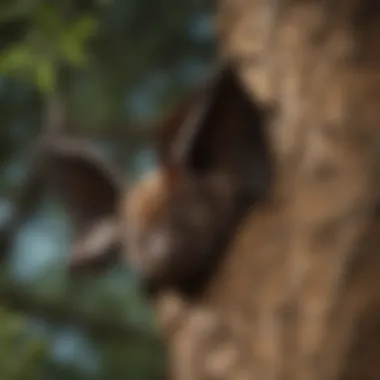The Crucial Role of Bat Protection in Ecosystems


Intro
Bats are often overlooked despite their critical importance in our ecosystems. Their behaviors and biological functions contribute significantly to biodiversity and the overall health of the environment. This article seeks to illuminate the reasons behind bat protection and the consequences of their decline. To grasp why these mammals need safeguarding, we must explore the broader context of woodland ecosystems and examine how these systems function holistically.
Understanding Woodland Ecosystems
The interdependence in woodland ecosystems is complex. Each species plays a part in maintaining ecological balance, with bats residing at the forefront due to their multiple roles.
Importance of Biodiversity in Forests
Biodiversity in forests is paramount. It ensures resilience against diseases and climate variations. Bats, as dynamic foragers, control insect populations. Their pursuit of insects prevents the overpopulation of pests. Moreover, they participate in pollination and seed dispersal processes, vital for various tree species and other plants.
A decline in bat populations can lead to a domino effect. This may increase pests that harm not only plants but also the agricultural output. In turn, this affects food security and livelihoods for communities reliant on agriculture.
Role of Forests in Climate Regulation
Forests serve as critical carbon sinks, mitigating climate change effects. Bats contribute to this function indirectly. Healthy bat populations promote diverse plant growth and support healthy forest ecosystems. This, in turn, plays a key role in carbon absorption. When forests flourish, they sequester carbon, thereby helping combat global warming. The synergy between bats and forests emphasizes their ecological importance far beyond their physical presence.
Sustainable Forestry Practices
The integration of bats into sustainable forestry practices is essential for ecological integrity. Promoting practices that prioritize both forestry production and ecological health fosters long-term benefits.
Principles of Sustainable Forestry
Sustainable forestry emphasizes balancing ecological needs with economic demands. Key principles include:
- Conservation of biodiversity: Maintaining diverse plant and animal life within forested areas.
- Minimization of environmental impact: Using harvesting techniques that reduce ecological disruption.
- Community engagement: Involving local communities in decision-making around forest management.
These principles create a robust framework that ensures the longevity of forests and the wildlife that depends on them, including bats.
Case Studies of Successful Implementations
Certain regions have seen success in integrating bat protection within forestry practices. For example, the Northern Forests in the United States have implemented bat-friendly initiatives. These efforts focus on preserving roosting sites and ensuring a sustainable food supply for bats through pest control measures. Research shows that communities benefiting from such initiatives report healthier forests and enhanced biodiversity.
Woodland Stewardship Techniques
Effective stewardship techniques are vital to maintaining bat populations and overall forest health. Strategic planning and active management can protect these species while fostering a thriving woodland environment.
Forest Management Plans
Comprehensive forest management plans should include methods for preserving bat habitats, identifying critical roosting sites, and ensuring minimal disturbance during their active periods. Plans must consider:
- Species specific needs: Tailoring management strategies to the requirements of different bat species.
- Monitoring populations: Regular audits to track bat numbers and health, ensuring timely intervention if needed.
Conservation Strategies
Conservation strategies encompass a range of approaches. Active habitat restoration is key. This includes activities such as:
- Replanting native flora to provide shelter and food.
- Creating artificial roosting structures to compensate for lost habitats.
Mobilizing public awareness about the importance of bats and engaging communities plays a crucial role. Promoting educational programmes ensures that the community understands the benefits bats bring, fostering a sense of stewardship.
Protecting bat populations is not just good for bats; it's critical for the ecosystems they support and the agricultural industries that depend on healthy forests.
Understanding Bats and Their Role
Bats are essential components of many ecosystems, playing multifaceted roles that contribute to biodiversity and stability. Their presence indicates a healthy environment. Understanding the importance of bats allows us to appreciate these creatures beyond their often misunderstood reputation. This section explores various aspects of their function in ecosystems, focusing on their contributions to biodiversity, agricultural benefits through insect control, and roles in pollination and seed dispersal.


Biodiversity and Ecosystem Health
Bats are considered bioindicators, meaning their populations reflect the state of the ecosystem. A decline in bat numbers often signals broader environmental issues, such as habitat loss or climate change. For instance, as insectivorous bats consume vast quantities of insects, they help regulate pest populations. This natural pest control supports agricultural health and decreases reliance on chemical pesticides.
The decline of bats threatens the intricate web of life. Diverse habitats benefit from various bat species; each species fulfills its niche. When bat populations dwindle, the resulting imbalance can lead to overpopulation of certain insects, causing crop damage and further environmental stress. Moreover, bats compete with birds and other insectivores. Therefore, their absence can significantly alter community dynamics.
Insect Control and Agricultural Benefits
Bats consume vast amounts of insects nightly, with some species dining on over a thousand insects in a single evening. This capability makes them effective agents of natural pest control. Farmers benefit greatly from the predation of agricultural pests by bats. For example, the little brown bat can reduce the need for pesticides, ultimately saving farmers money and promoting sustainable farming techniques.
Furthermore, certain crops are directly influenced by bat populations. A study indicated that bats' presence can lead to a 30% increase in corn yields, showcasing their importance to food security. Reducing insect populations not only aids local farmers but also supports wider agricultural practices. Promoting bat protection can thus have far-reaching economic benefits across regions.
Pollination and Seed Dispersal
Many bat species contribute to pollination and seed dispersal, especially in tropical ecosystems. Fruit-eating bats, such as the spectacled flying fox, consume fruits and then excrete seeds over considerable distances. This behavior aids in forest regeneration and maintains plant diversity.
In addition to spreading seeds, bats pollinate specific flowering plants, some of which are crucial for local agriculture. The agave plant, which is used to produce tequila, is one example. Without bats, these plants would struggle to reproduce. Thus, recognizing bats' contributions to pollination is vital for preserving not just their populations but also the broader ecosystems that depend on their activities.
"Bats contribute significantly to biodiversity, agricultural productivity, and ecosystem health. Their protection is essential in the face of numerous environmental threats."
Threats Facing Bat Populations
The threats facing bat populations have grown more prevalent and complex over the years. Understanding these challenges is crucial for forest management and biodiversity preservation. Bats are integral to various ecosystems, and their decline can trigger a cascade of effects. Identifying these threats leads to a better approach in conservation efforts. Many bat species are already endangered or vulnerable due to these pressures, making our understanding and action timely.
Habitat Loss and Fragmentation
Habitat loss is one of the primary threats to bats. It often occurs due to urbanization, agriculture expansion, and deforestation. When habitats are fragmented, it splits bat populations, disrupting their mating patterns and increasing the risk of extinction. In fragmented environments, bats struggle to forage for food and find roosting sites. This leads to decreased population sizes and genetic diversity.
Some key points to consider regarding habitat loss are:
- Bats need large foraging areas to thrive.
- Oil and gas drilling affect their natural habitats, leading to increased stress.
- Roosting sites, often in trees or caves, are destroyed or altered.
Climate Change and Its Impact
Climate change presents a crucial challenge for bat populations. Increased temperatures can shift the availability of food sources and alter migration patterns. Changes in weather patterns affect the insects that bats feed on. In some regions, droughts reduce the number of insects, leading to food scarcity. Similarly, heavy rainfall can impact their roosting sites and disturb maternity colonies.
It’s essential to recognize the effects of climate change on bats:
- Increased temperatures can lead to higher mortality rates among bat pups.
- Reduced insect populations result in diminished food resources.
- Altered seasonal patterns can affect bat hibernation and reproduction.
Disease Outbreaks
Disease outbreaks also pose significant risks to bat populations. One notable example is white-nose syndrome, caused by a fungus. This disease has devastated several bat species across North America. Infected bats awaken too frequently during hibernation, leading to energy depletion and death. Understanding the spread and impact of diseases is critical for managing bat health and populations.
Important considerations regarding disease include:
- The rapid spread of infectious diseases can wipe out entire colonies.
- Bat populations in close proximity are more vulnerable.
- Preventative measures, like reducing human disturbances in hibernacula, can mitigate outbreaks.
The necessity for comprehensive climate action, habitat restoration, and disease management is paramount for the survival of bat populations.
Legislation and Protections for Bats
Bats play a significant role in the ecosystem, and protecting them is vital not only for their survival but also for the health of the environment. Legislation targeting bat protection has emerged from the recognition of their essential functions such as pest control, pollination, and seed dispersal. Legal protections can help mitigate threats like habitat destruction and climate change.
Effective bat protection legislation offers multiple benefits. Firstly, it helps stabilize bat populations which are crucial for biodiversity. Secondly, it establishes a framework for engaging local communities in conservation efforts. Finally, it sets standards for habitat conservation and restoration that directly benefit the greater ecosystem.
Endangered Species Act
The Endangered Species Act (ESA) is a key piece of legislation in the United States designed to protect threatened and endangered species, including various bat species. Under the ESA, habitats critical for the survival of these species are identified and protected. This strongest layer of protection saves not only the bats but also promotes the biodiversity in those areas.


Key provisions of the ESA include:
- Listing Species: Certain bat species are listed as endangered or threatened.
- Habitat Protection: Critical habitats are designated and cannot be altered without approval.
- Recovery Plans: Efforts must be made to develop plans that ensure species recovery.
The law also mandates federal authorities to avoid actions that would jeopardize the species, making it an essential tool in bat conservation.
International Agreements
Various international agreements recognize the need for bat protection on a global scale. Agreements like the Convention on Migratory Species (CMS) focus on the conservation of migratory species, including bats. By facilitating cooperation across national boundaries, these agreements enhance conservation efforts.
Such agreements often include:
- Funding for Research: Support for research programs aims to better understand bat behaviors and population dynamics.
- Collaborative Conservation Strategies: Countries work together to implement strategies that protect bats across their migratory routes.
- Awareness Campaigns: Initiatives aimed at educating the public about the significance of bats in ecosystems.
International cooperation is critical since many bat species migrate long distances and do not adhere to human-imposed borders.
Local and State Regulations
Local and state regulations also play an essential role in bat protection. These rules can complement federal laws like the ESA by addressing specific regional issues affecting bat populations.
Some important aspects of local and state regulations include:
- Permitting for Land Use: In many states, permits are required for activities that may impact bat habitats, such as logging or land development.
- Species Protection Laws: States may enact laws that protect specific bat species not covered by federal legislation.
- Public Education Initiatives: Local governments often help educate communities about bats and the benefits of protecting them.
Engaging local stakeholders in conservation efforts leads to more tailored and effective strategies that consider community needs and ecological realities.
"The success of bat conservation hinges on the ability of legislation to enforce protection measures and engage communities in the effort."
The Role of Conservation Organizations
Conservation organizations play a pivotal role in safeguarding bat populations and, by extension, the ecosystems that depend on them. Their efforts encompass a wide array of activities such as field research, advocacy, education, and habitat restoration. These organizations serve as crucial intermediaries between scientific research and public policy, ensuring that the value of bats in ecosystems is communicated effectively to stakeholders. With various threats facing bat populations, the role of these entities becomes increasingly important.
Field Research and Data Collection
Field research is fundamental to understanding bat behavior, ecology, and population dynamics. Through systematic data collection, conservation organizations can identify which species are under threat, the specific habitats they occupy, and the ecological roles they fulfill. This research informs conservation strategies and policy initiatives. For instance, organizations like the Bat Conservation International use acoustic monitoring to track bat populations and gather vital information on their foraging habits. As more data becomes available, it allows for informed decision-making to enhance bat conservation efforts and habitat protection.
Public Awareness Campaigns
Public awareness campaigns are another critical aspect of conservation organizations' work. These initiatives aim to educate the public about the ecological significance of bats and the challenges they face. Engaging campaigns can help shift public perception, reducing fear and misunderstanding about these creatures. Educational materials, workshops, and social media outreach are common methods used by organizations to promote the importance of bat conservation. Furthermore, by fostering a sense of stewardship among communities, these campaigns can lead to increased local support for conservation efforts, turning citizens into advocates for bat-friendly practices.
Habitat Restoration Efforts
Habitat restoration is a direct way to improve bat populations and their ecosystems. Many conservation organizations engage in restoration projects that focus on reestablishing natural habitats that bats rely on for food and shelter. This can involve reforestation, improving water quality in streams where bats feed, or maintaining roost sites. For example, the Nature Conservancy has initiated projects that not only focus on bats but also promote overall biodiversity. By restoring habitats, conservation organizations contribute significantly to the recovery of bat species and the overall health of the environments they inhabit.
"Conservation organizations are essential not only for preserving bats but for sustaining the balance of our ecosystems."
Community Involvement in Bat Conservation
Community engagement is critical for successful bat conservation. By involving individuals and groups in local conservation efforts, we can enhance awareness and impact on bat populations. The intricate relationship between communities and bat protection highlights how grassroots movements can drive conservation initiatives.
Educational Programs for Schools
Educational programs targeting schools can play a pivotal role in fostering understanding and appreciation for bats. By incorporating bat-related science topics into school curriculums, students can learn about bats' ecological roles and their direct benefits to agriculture, forestry, and overall ecosystem health. These programs often include interactive activities such as
- Field trips to bat habitats
- Workshops on bat biology
- Projects on local bat species
With support from educators and conservationists, young people can develop a sense of ownership over local wildlife. This early exposure not only builds knowledge but also instills a passion for environmental stewardship that can last a lifetime.
Stakeholder Engagement in Forest Management


Engagement of various stakeholders is vital in forest management systems. This includes local communities, government bodies, conservation organizations, and landowners. Involving these groups can ensure that bat conservation is part of broader land management plans. For example, stakeholders can collaborate on strategies such as:
- Implementing bat-friendly forestry practices.
- Assessing the impact of logging on local bat populations.
- Developing policies to minimize habitat disturbance.
Such cooperative efforts lead to more sustainable management of forest ecosystems. It underscores the need for ensuring that bat conservation becomes a critical consideration in land-use planning and decision-making.
Citizen Science Initiatives
Citizen science initiatives offer a practical way for community members to engage in bat conservation efforts. These programs encourage non-professionals to collect data, monitor bat populations, and contribute to scientific research. By empowering individuals to participate, such as:
- Conducting bat count surveys
- Reporting bat sightings
- Tracking migrations through established networks
citizen scientists provide valuable contributions to understanding bat ecology. This not only enhances data collection but also fosters a deeper connection between communities and their natural environments.
Future Directions in Bat Protection
Understanding the future directions in bat protection is essential. The preservation of bats is not only vital for their species but is also crucial for the overall integrity of ecosystems. Innovation and strategy will guide the future of conservation efforts. By focusing on specific elements such as emerging technologies and integrated approaches, we can enhance the effectiveness of bat protection.
Innovative Technologies in Monitoring
Innovative technologies are transforming how we monitor bat populations. Traditional methods such as visual surveys are being complemented by advanced tools. Acoustic monitoring devices, for example, can gather data on bat calls, helping researchers identify species presence and behavior patterns without intrusive measures.
Remote sensing technologies, such as drones and satellite imagery, enable a broader view of habitats, which assists in assessing their conditions. This is significant as it provides researchers with real-time data. Understanding bat distribution and their habitat use patterns can improve conservation planning.
Moreover, smartphone applications now allow citizen scientists to contribute to bat monitoring. By enabling members of the community to record bat sightings or sounds, we create a more extensive dataset. This approach fosters greater public interest in conservation efforts, highlighting the importance of community involvement.
Integrated Conservation Strategies
Integrated conservation strategies are vital for maintaining bat populations. Approaching bat protection requires a holistic perspective that includes habitat preservation, land-use practices, and stakeholder collaboration. Techniques such as landscape-level planning will form the backbone of these strategies.
Various stakeholders, including landowners, local governments, and environmental groups, must collaborate. Such collaborations can facilitate sustainable land use that mitigates potential conflicts between human activities and bat habitats. For example, incorporating bat habitat needs into forestry practices can enhance the survival rates of bat populations.
Furthermore, combined efforts in policy formation, research, and public awareness campaigns create a robust framework. This allows various strategies to work in unison rather than in isolation. When all parties are aligned in their goals, the chances of success improve significantly.
Building Ecosystem Resilience
Building ecosystem resilience includes not only protecting bats but also enhancing the ecosystems where they thrive. Creating resilient ecosystems can help bat populations adapt to changing environmental conditions. This involves restoring degraded habitats and preserving critical areas that support bat breeding and foraging.
Increased biodiversity through habitat restoration efforts offers bats more resources. This plays a crucial role in stabilizing populations against disease and climate change impacts. Additionally, protected areas need to be adaptable. As environmental conditions shift, these areas should support both the bat populations and the broader biodiversity.
Fostering relationships between different species in ecosystems ensures nutrient cycles and energy flows remain uninterrupted. By maintaining a balance, we promote robust ecosystems that can better withstand disturbances, thereby supporting bat conservation comprehensively.
Building a future where bats thrive necessitates innovative thinking and collaborative efforts. It is only through these concerted actions that we can protect bats effectively and ensure the stability of the ecosystems they represent.
The End
The significance of addressing bat protection within ecosystems cannot be overstated. As a vital component of biodiversity, bats contribute to ecological health in various ways. Their role in insect control, pollination, and seed dispersal underlines the necessity to understand their place within food webs. The decline of bat populations threatens these vital services and poses a risk to environmental stability.
The Urgency of Bat Conservation
With habitats undergoing rapid changes, from urban expansion to climate change, the urgency for bat conservation grows. Bats face multifaceted challenges that require an immediate response from conservationists, policymakers, and the public. Each species of bat has its own niche, providing unique benefits to the ecosystem. Losing any of them results in a disruption of ecological balance, which could have cascading effects.
Insects, many of which are crop pests, are kept in check by bat predation. A decline in bat species often leads to an increase in insect populations, which can result in higher pesticide use, ultimately harming the environment and human health.
Call to Action for Stakeholders
It is essential for all stakeholders involved—farmers, policymakers, conservationists, and the general public—to recognize their role in bat protection. Stakeholders should actively participate in education programs and community engagement initiatives aimed at enhancing understanding of bats' ecological importance.
Several steps can be taken:
- Support Legislation: Advocate for laws that protect bat habitats and regulate pesticide use.
- Engage in Citizen Science: Participate in monitoring programs to help track bat populations.
- Promote Habitat Restoration: Join efforts to restore wooded areas where bats roost and forage.
"Collaboration is key to ensuring the survival of bats and, subsequently, the health of our ecosystems."
Only through collaborative efforts can we address the risks faced by bats and secure their future in our ecosystems, which in turn safeguards the entire environmental framework.







